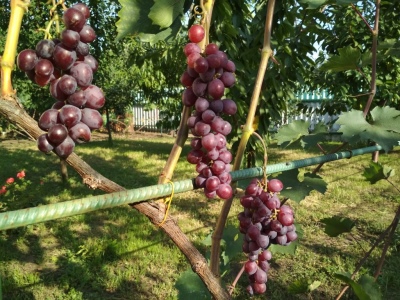
- Authors: Bilash Vladimir Mikhailovich
- Berry color: Red
- Taste: nutmeg
- Ripening period: early
- Ripening period, days: 90-100
- Frost resistance, ° C: -32
- Bunch weight, g: 700 and more
- Flower type: bisexual
- Density of the bunch: medium density and loose
- Skin: not thick, not prone to cracking
The taste qualities of any culture are highly valued among gardeners, for many years they have been looking for this or that taste. The amazement grape, according to gardeners, has excellent taste. In this article, we will consider the history of breeding, features of selection, ripening time and yield, as well as agrotechnical aspects and winter hardiness.
Breeding history
The grape variety was presented to the public in 2011 by the breeder V.M.Bilash. The grape varieties Surprise Belash and Victoria were chosen for the parent couple.
Description
The bushes are vigorous, grow up to 3-4 m. Laza grows quickly and fully matures for 2 years after planting in the ground. The branches are thick and strong, light brown in color. They twist very much, therefore it is necessary to install a trellis system. Leaves are medium in size, green in color, wedge-shaped. There is a cross-section in the middle, the upper surface is smooth, the reverse side is matte with slight pubescence. There are quite a few leaves on the bush.
Many gardeners note that this culture has high immunity and frost resistance. The variety belongs to the early ripening period. The bushes easily take root in a new place, they reproduce well by cuttings, they take root well. Therefore, dividing by cuttings is one of the popular methods for propagating this culture.
Ripening period
The grape variety Astonishment belongs to the early ripening, and the fruit ripening period itself varies from 90 to 100 days. Flowering occurs in May, and the first harvest can be taken in early or mid-August.
Bunches
Bunches are conical in shape, large, looseness may appear in places, especially if the vine is overloaded. By weight, one brush pulls 500-700 g. With proper agrotechnical work, good care of the bush, the weight of one brush can increase.
Berries
Fruits are oval-elongated or ovoid in shape. By weight, the berries vary from 10 to 12 g. The shade of the berries is deep red or burgundy, in the light it may seem that the skin is slightly transparent.
The berries do not change their color throughout the season, even after full ripening. The skin is compacted, no cracks on the fruit are observed, only in case of any diseases. The pulp is juicy, fleshy and dense, slightly crunchy.
Taste
The taste is pleasant, nutmeg and sweet. There is a grape aftertaste.
Yield
Gardeners note the high yield of the variety.


Growing features
Each crop must be properly cared for in order for it to have good yields. The Izumlenie grape variety is thermophilic, so it should be planted on the sunny side of the site where the wind blows least.
Due to the fact that the vines grow quickly, the grapes can be planted next to the gazebo, and the vines can be tied to it. It should be planted on the sunny side so that the grapes are not in the shade for most of the day.
The selected area should be dry, water should not accumulate there, and groundwater should not pass underground at a level of 2-3 m. This is necessary so that the root system develops correctly and does not rot over time. Excessive moisture in the roots can lead to the fact that the fruits begin to shrink.
The soil should be loamy, loose and sandy. It is best to dig up the selected area with minerals before planting the seedlings so that the earth is not only saturated with oxygen, but also with useful qualities that the seedling needs.
Landing
Planting seedlings can be carried out both in spring and autumn. Since the culture has high frost resistance. The parameter of the fossa should be as follows: 0.8 m in depth, the diameter of the fossa is 0.5-0.8 cm. A trellis is installed next to the hole. Drainage from pebbles or broken bricks is laid out on the bottom. Then the drainage is covered with a layer of loose earth, after which a seedling is lowered into the hole and gradually covered with earth. After planting the seedling in the ground, the earth around is spilled abundantly with water.
If the disembarkation took place in the fall, then it is best to do this before the first frost.

Pollination
The hybrid has stunned peduncles of both sexes, so the plant does not require additional pollination.
Pruning
Pruning always takes place in several stages. In the spring, dry vines are cut, those that have been broken, and branches that have not left after winter. In the summer, pruning occurs in order to remove unnecessary side shoots from the outlet that do not bear fruit and will not. And also the excess foliage at the bottom of the vine is removed, and if it grows abundantly above the bunches. In autumn, the vines are shortened, on average 6-8 eyes are cut off. Branches that have been bearing fruit for more than 3 years are removed. Places of cuts are processed with garden varnish so that insects cannot get there.



Frost resistance and the need for shelter
The bushes do not need to be covered for the winter, since the frost resistance of this hybrid is -32 degrees.

Diseases and pests
The grape variety has high indicators of resistance to diseases and pests, but as a preventive measure, it is still worth spraying the bushes.

If a grape is exposed to any disease or insect, this always affects its appearance.
Storage
The variety is distinguished by good transportability and a shelf life of up to 1.5 months.











































































